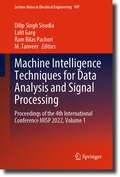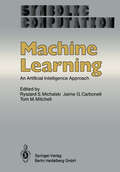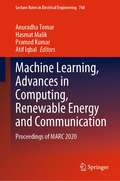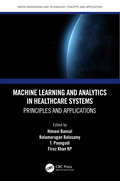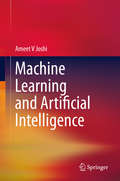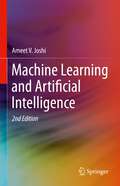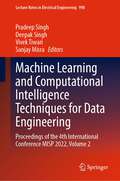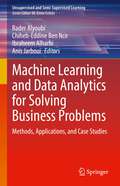- Table View
- List View
Machine Intelligence Techniques for Data Analysis and Signal Processing: Proceedings of the 4th International Conference MISP 2022, Volume 1 (Lecture Notes in Electrical Engineering #997)
by Dilip Singh Sisodia Lalit Garg Ram Bilas Pachori M. TanveerThis book comprises the proceedings of the 4th International Conference on Machine Intelligence and Signal Processing (MISP2022). The contents of this book focus on research advancements in machine intelligence, signal processing, and applications. The book covers the real-time challenges involved while processing big data analytics and stream processing with the integration of smart data computing services and interconnectivity. It also includes the progress in signal processing to process the normal and abnormal categories of real-world signals such as signals generated from IoT devices, smart systems, speech, and videos and involves biomedical signal processing: electrocardiogram (ECG), electroencephalogram (EEG), magnetoencephalography (MEG), electromyogram (EMG), etc. This book proves a valuable resource for those in academia and industry.
Machine Intelligence, Tools, and Applications: Proceedings of the International Conference on Machine Intelligence, Tools, and Applications—ICMITA 2024 (Learning and Analytics in Intelligent Systems #40)
by Satchidananda Dehuri Ashish Ghosh Sung-Bae Cho Venkat Prasad Padhy Poonkuntrun ShanmugamThis book presents the recent advances including tools and techniques in the constantly changing landscape of machine learning (ML). This would enable the readers with a strong understanding of critical issues in ML by providing both broad and detailed perspectives on cutting-edge theories, algorithms, and tools. This will become a single source of reference on conceptual, methodological, technical, and managerial issues, as well as provide insight into emerging trends and future opportunities in the discipline of ML. This book contains altogether 36 chapters in the area of ML and its applications.
Machine Learning: An Artificial Intelligence Approach (Symbolic Computation)
by R. S. Michalski J. G. Carbonell T. M. MitchellThe ability to learn is one of the most fundamental attributes of intelligent behavior. Consequently, progress in the theory and computer modeling of learn ing processes is of great significance to fields concerned with understanding in telligence. Such fields include cognitive science, artificial intelligence, infor mation science, pattern recognition, psychology, education, epistemology, philosophy, and related disciplines. The recent observance of the silver anniversary of artificial intelligence has been heralded by a surge of interest in machine learning-both in building models of human learning and in understanding how machines might be endowed with the ability to learn. This renewed interest has spawned many new research projects and resulted in an increase in related scientific activities. In the summer of 1980, the First Machine Learning Workshop was held at Carnegie-Mellon University in Pittsburgh. In the same year, three consecutive issues of the Inter national Journal of Policy Analysis and Information Systems were specially devoted to machine learning (No. 2, 3 and 4, 1980). In the spring of 1981, a special issue of the SIGART Newsletter No. 76 reviewed current research projects in the field. . This book contains tutorial overviews and research papers representative of contemporary trends in the area of machine learning as viewed from an artificial intelligence perspective. As the first available text on this subject, it is intended to fulfill several needs.
Machine Learning Adoption in Blockchain-Based Intelligent Manufacturing: Theoretical Basics, Applications, and Challenges (Intelligent Manufacturing and Industrial Engineering)
by Ahmed A. Elngar Om Prakash Jena Sabyasachi PramanikThis book looks at industry change patterns and innovations (such as artificial intelligence, machine learning, big data analysis, and blockchain support and efficiency technology) that are speeding up industrial transformation, industrial infrastructure, biodiversity, and productivity. This book focuses on real-world industrial applications and case studies to provide for a wider knowledge of intelligent manufacturing. It also offers insights into manufacturing, logistics, and supply chain, where systems have undergone an industrial transformation. It discusses current research of machine learning along with blockchain techniques that can fill the gap between research and industrial exposure. It goes on to cover the effects that the Fourth Industrial Revolution has on industrial infrastructures and looks at the current industry change patterns and innovations that are accelerating industrial transformation activities. Researchers, scholars, and students from different countries will appreciate this book for its real-world applications and knowledge acquisition. This book targets manufacturers, industry owners, product developers, scientists, logistics, and supply chain engineers. Focuses on real-world industrial applications and case studies to provide for a wider knowledge of intelligent manufacturing Offers insights into manufacturing, logistics, and supply chain where systems have undergone an industrial transformation Discusses current research of machine learning along with blockchain techniques that can fill the gap between research and industrial exposure Covers the effects that the 4th Industrial Revolution has on industrial infrastructures Looks at industry change patterns and innovations that are speeding up industrial transformation activities Om Prakash Jena is currently working as an associate professor in the Department of Computer Science, Ravenshaw University, Cuttack, Odisha, India. Sabyasachi Pramanik is an assistant professor in the Department of Computer Science and Engineering, Haldia Institute of Technology, India. Ahmed A. Elngar is an associate professor in the Faculty of Computers & Artificial Intelligence, Beni-Suef University, Egypt. He is also an associate professor in the College of Computer Information Technology, chair of the Scientific Innovation Research Group (SIRG), and director of the Technological and Informatics Studies Center (TISC), American University in the Emirates, United Arab Emirates.
Machine Learning Adoption in Blockchain-Based Intelligent Manufacturing: Theoretical Basics, Applications, and Challenges (Intelligent Manufacturing and Industrial Engineering)
by Ahmed A. Elngar Om Prakash Jena Sabyasachi PramanikThis book looks at industry change patterns and innovations (such as artificial intelligence, machine learning, big data analysis, and blockchain support and efficiency technology) that are speeding up industrial transformation, industrial infrastructure, biodiversity, and productivity. This book focuses on real-world industrial applications and case studies to provide for a wider knowledge of intelligent manufacturing. It also offers insights into manufacturing, logistics, and supply chain, where systems have undergone an industrial transformation. It discusses current research of machine learning along with blockchain techniques that can fill the gap between research and industrial exposure. It goes on to cover the effects that the Fourth Industrial Revolution has on industrial infrastructures and looks at the current industry change patterns and innovations that are accelerating industrial transformation activities. Researchers, scholars, and students from different countries will appreciate this book for its real-world applications and knowledge acquisition. This book targets manufacturers, industry owners, product developers, scientists, logistics, and supply chain engineers. Focuses on real-world industrial applications and case studies to provide for a wider knowledge of intelligent manufacturing Offers insights into manufacturing, logistics, and supply chain where systems have undergone an industrial transformation Discusses current research of machine learning along with blockchain techniques that can fill the gap between research and industrial exposure Covers the effects that the 4th Industrial Revolution has on industrial infrastructures Looks at industry change patterns and innovations that are speeding up industrial transformation activities Om Prakash Jena is currently working as an associate professor in the Department of Computer Science, Ravenshaw University, Cuttack, Odisha, India. Sabyasachi Pramanik is an assistant professor in the Department of Computer Science and Engineering, Haldia Institute of Technology, India. Ahmed A. Elngar is an associate professor in the Faculty of Computers & Artificial Intelligence, Beni-Suef University, Egypt. He is also an associate professor in the College of Computer Information Technology, chair of the Scientific Innovation Research Group (SIRG), and director of the Technological and Informatics Studies Center (TISC), American University in the Emirates, United Arab Emirates.
Machine Learning, Advances in Computing, Renewable Energy and Communication: Proceedings of MARC 2020 (Lecture Notes in Electrical Engineering #768)
by Pramod Kumar Atif Iqbal Hasmat Malik Anuradha TomarThis book gathers selected papers presented at International Conference on Machine Learning, Advances in Computing, Renewable Energy and Communication (MARC 2020), held in Krishna Engineering College, Ghaziabad, India, during December 17–18, 2020. This book discusses key concepts, challenges, and potential solutions in connection with established and emerging topics in advanced computing, renewable energy, and network communications.
Machine Learning Algorithms: Adversarial Robustness in Signal Processing (Wireless Networks)
by Fuwei Li Lifeng Lai Shuguang CuiThis book demonstrates the optimal adversarial attacks against several important signal processing algorithms. Through presenting the optimal attacks in wireless sensor networks, array signal processing, principal component analysis, etc, the authors reveal the robustness of the signal processing algorithms against adversarial attacks. Since data quality is crucial in signal processing, the adversary that can poison the data will be a significant threat to signal processing. Therefore, it is necessary and urgent to investigate the behavior of machine learning algorithms in signal processing under adversarial attacks. The authors in this book mainly examine the adversarial robustness of three commonly used machine learning algorithms in signal processing respectively: linear regression, LASSO-based feature selection, and principal component analysis (PCA). As to linear regression, the authors derive the optimal poisoning data sample and the optimal feature modifications, and also demonstrate the effectiveness of the attack against a wireless distributed learning system. The authors further extend the linear regression to LASSO-based feature selection and study the best strategy to mislead the learning system to select the wrong features. The authors find the optimal attack strategy by solving a bi-level optimization problem and also illustrate how this attack influences array signal processing and weather data analysis. In the end, the authors consider the adversarial robustness of the subspace learning problem. The authors examine the optimal modification strategy under the energy constraints to delude the PCA-based subspace learning algorithm. This book targets researchers working in machine learning, electronic information, and information theory as well as advanced-level students studying these subjects. R&D engineers who are working in machine learning, adversarial machine learning, robust machine learning, and technical consultants working on the security and robustness of machine learning are likely to purchase this book as a reference guide.
Machine Learning Algorithms and Applications in Engineering (Smart and Intelligent Computing in Engineering)
by Prasenjit Chatterjee Morteza Yazdani Francisco Fernández-Navarro Javier Pérez-RodríguezMachine Learning (ML) is a sub field of artificial intelligence that uses soft computing and algorithms to enable computers to learn on their own and identify patterns in observed data, build models that explain the world, and predict things without having explicit pre-programmed rules and models. This book discusses various applications of ML in engineering fields and the use of ML algorithms in solving challenging engineering problems ranging from biomedical, transport, supply chain and logistics, to manufacturing and industrial. Through numerous case studies, it will assist researchers and practitioners in selecting the correct options and strategies for managing organizational tasks.
Machine Learning Algorithms and Applications in Engineering (Smart and Intelligent Computing in Engineering)
by Prasenjit Chatterjee Morteza Yazdani Francisco Fernández-Navarro Javier Pérez-RodríguezMachine Learning (ML) is a sub field of artificial intelligence that uses soft computing and algorithms to enable computers to learn on their own and identify patterns in observed data, build models that explain the world, and predict things without having explicit pre-programmed rules and models. This book discusses various applications of ML in engineering fields and the use of ML algorithms in solving challenging engineering problems ranging from biomedical, transport, supply chain and logistics, to manufacturing and industrial. Through numerous case studies, it will assist researchers and practitioners in selecting the correct options and strategies for managing organizational tasks.
Machine Learning Algorithms for Industrial Applications (Studies in Computational Intelligence #907)
by Santosh Kumar Das Shom Prasad Das Nilanjan Dey Aboul-Ella HassanienThis book explores several problems and their solutions regarding data analysis and prediction for industrial applications. Machine learning is a prominent topic in modern industries: its influence can be felt in many aspects of everyday life, as the world rapidly embraces big data and data analytics. Accordingly, there is a pressing need for novel and innovative algorithms to help us find effective solutions in industrial application areas such as media, healthcare, travel, finance, and retail. In all of these areas, data is the crucial parameter, and the main key to unlocking the value of industry. The book presents a range of intelligent algorithms that can be used to filter useful information in the above-mentioned application areas and efficiently solve particular problems. Its main objective is to raise awareness for this important field among students, researchers, and industrial practitioners.
Machine Learning Algorithms for Signal and Image Processing
by Deepika Ghai Suman Lata Tripathi Sobhit Saxena Manash Chanda Mamoun AlazabMachine Learning Algorithms for Signal and Image Processing Enables readers to understand the fundamental concepts of machine and deep learning techniques with interactive, real-life applications within signal and image processing Machine Learning Algorithms for Signal and Image Processing aids the reader in designing and developing real-world applications using advances in machine learning to aid and enhance speech signal processing, image processing, computer vision, biomedical signal processing, adaptive filtering, and text processing. It includes signal processing techniques applied for pre-processing, feature extraction, source separation, or data decompositions to achieve machine learning tasks. Written by well-qualified authors and contributed to by a team of experts within the field, the work covers a wide range of important topics, such as: Speech recognition, image reconstruction, object classification and detection, and text processing Healthcare monitoring, biomedical systems, and green energy How various machine and deep learning techniques can improve accuracy, precision rate recall rate, and processing time Real applications and examples, including smart sign language recognition, fake news detection in social media, structural damage prediction, and epileptic seizure detection Professionals within the field of signal and image processing seeking to adapt their work further will find immense value in this easy-to-understand yet extremely comprehensive reference work. It is also a worthy resource for students and researchers in related fields who are looking to thoroughly understand the historical and recent developments that have been made in the field.
Machine Learning Algorithms for Signal and Image Processing
by Suman Lata Tripathi Deepika Ghai Sobhit Saxena Manash Chanda Mamoun AlazabEnables readers to understand the fundamental concepts of machine and deep learning techniques with interactive, real-life applications within signal and image processing Machine Learning Algorithms for Signal and Image Processing aids the reader in designing and developing real-world applications using advances in machine learning to aid and enhance speech signal processing, image processing, computer vision, biomedical signal processing, adaptive filtering, and text processing. It includes signal processing techniques applied for pre-processing, feature extraction, source separation, or data decompositions to achieve machine learning tasks. Written by well-qualified authors and contributed to by a team of experts within the field, the work covers a wide range of important topics, such as: Speech recognition, image reconstruction, object classification and detection, and text processing Healthcare monitoring, biomedical systems, and green energy How various machine and deep learning techniques can improve accuracy, precision rate recall rate, and processing time Real applications and examples, including smart sign language recognition, fake news detection in social media, structural damage prediction, and epileptic seizure detectionProfessionals within the field of signal and image processing seeking to adapt their work further will find immense value in this easy-to-understand yet extremely comprehensive reference work. It is also a worthy resource for students and researchers in related fields who are looking to thoroughly understand the historical and recent developments that have been made in the field.
Machine Learning and Analytics in Healthcare Systems: Principles and Applications (Green Engineering and Technology)
by Himani Bansal Balamurugan Balusamy T. Poongodi Firoz Khan KpThis book provides applications of machine learning in healthcare systems and seeks to close the gap between engineering and medicine. It will combine the design and problem-solving skills of engineering with health sciences, in order to advance healthcare treatment. The book will include areas such as diagnosis, monitoring, and therapy. The book will provide real-world case studies, gives a detailed exploration of applications in healthcare systems, offers multiple perspectives on a variety of disciplines, while also letting the reader know how to avoid some of the consequences of old methods with data sharing. The book can be used as a reference for practitioners, researchers and for students at basic and intermediary levels in Computer Science, Electronics and Communications.
Machine Learning and Analytics in Healthcare Systems: Principles and Applications (Green Engineering and Technology)
by Himani Bansal, Balamurugan Balusamy, T. Poongodi, and Firoz Khan KPThis book provides applications of machine learning in healthcare systems and seeks to close the gap between engineering and medicine. It will combine the design and problem-solving skills of engineering with health sciences, in order to advance healthcare treatment. The book will include areas such as diagnosis, monitoring, and therapy. The book will provide real-world case studies, gives a detailed exploration of applications in healthcare systems, offers multiple perspectives on a variety of disciplines, while also letting the reader know how to avoid some of the consequences of old methods with data sharing. The book can be used as a reference for practitioners, researchers and for students at basic and intermediary levels in Computer Science, Electronics and Communications.
Machine Learning and Artificial Intelligence
by Ameet V JoshiThis book provides comprehensive coverage of combined Artificial Intelligence (AI) and Machine Learning (ML) theory and applications. Rather than looking at the field from only a theoretical or only a practical perspective, this book unifies both perspectives to give holistic understanding. The first part introduces the concepts of AI and ML and their origin and current state. The second and third parts delve into conceptual and theoretic aspects of static and dynamic ML techniques. The forth part describes the practical applications where presented techniques can be applied. The fifth part introduces the user to some of the implementation strategies for solving real life ML problems. The book is appropriate for students in graduate and upper undergraduate courses in addition to researchers and professionals. It makes minimal use of mathematics to make the topics more intuitive and accessible.Presents a full reference to artificial intelligence and machine learning techniques - in theory and application;Provides a guide to AI and ML with minimal use of mathematics to make the topics more intuitive and accessible;Connects all ML and AI techniques to applications and introduces implementations.
Machine Learning and Artificial Intelligence
by Ameet V JoshiThe new edition of this popular professional book on artificial intelligence (ML) and machine learning (ML) has been revised for classroom or training use. The new edition provides comprehensive coverage of combined AI and ML theory and applications. Rather than looking at the field from only a theoretical or only a practical perspective, this book unifies both perspectives to give holistic understanding. The first part introduces the concepts of AI and ML and their origin and current state. The second and third parts delve into conceptual and theoretic aspects of static and dynamic ML techniques. The fourth part describes the practical applications where presented techniques can be applied. The fifth part introduces the user to some of the implementation strategies for solving real life ML problems. Each chapter is accompanied with a set of exercises that will help the reader / student to apply the learnings from the chapter to a real-life problem. Completion of these exercises will help the reader / student to solidify the concepts learned. The book is appropriate for students in graduate and upper undergraduate courses in addition to researchers and professionals. It makes minimal use of mathematics to make the topics more intuitive and accessible. The book covers a large gamut of topics in the area of AI and ML and a professor can tailor a course on AI / ML based on the book by selecting and re-organizing the sequence of chapters to suit the needs.
Machine Learning and Artificial Intelligence in Healthcare Systems: Tools and Techniques (Artificial Intelligence in Smart Healthcare Systems)
by Tawseef Ayoub Shaikh Saqib Hakak Tabasum Rasool Mohammed WasidThis book provides applications of machine learning in healthcare systems and seeks to close the gap between engineering and medicine by combining design and problem-solving skills of engineering with health sciences to advance healthcare treatment. Machine Learning and Artificial Intelligence in Healthcare Systems: Tools and Techniques discusses AI-based smart paradigms for reliable prediction of infectious disease dynamics; such paradigms can help prevent disease transmission. It highlights the different aspects of using extended reality for diverse healthcare applications and aggregates the current state of research. The book offers intelligent models of the smart recommender system for personal well-being services and computer-aided drug discovery and design methods. Case studies illustrating the business processes that underlie the use of big data and health analytics to improve healthcare delivery are center stage. Innovative techniques used for extracting user social behavior (known as sentiment analysis for healthcare-related purposes) round out the diverse array of topics this reference book covers. Contributions from experts in the field, this book is useful to healthcare professionals, researchers, and students of industrial engineering, systems engineering, biomedical, computer science, electronics, and communications engineering.
Machine Learning and Artificial Intelligence in Healthcare Systems: Tools and Techniques (Artificial Intelligence in Smart Healthcare Systems)
by Tawseef Ayoub Shaikh Saqib Hakak Tabasum Rasool Mohammed WasidThis book provides applications of machine learning in healthcare systems and seeks to close the gap between engineering and medicine by combining design and problem-solving skills of engineering with health sciences to advance healthcare treatment. Machine Learning and Artificial Intelligence in Healthcare Systems: Tools and Techniques discusses AI-based smart paradigms for reliable prediction of infectious disease dynamics; such paradigms can help prevent disease transmission. It highlights the different aspects of using extended reality for diverse healthcare applications and aggregates the current state of research. The book offers intelligent models of the smart recommender system for personal well-being services and computer-aided drug discovery and design methods. Case studies illustrating the business processes that underlie the use of big data and health analytics to improve healthcare delivery are center stage. Innovative techniques used for extracting user social behavior (known as sentiment analysis for healthcare-related purposes) round out the diverse array of topics this reference book covers. Contributions from experts in the field, this book is useful to healthcare professionals, researchers, and students of industrial engineering, systems engineering, biomedical, computer science, electronics, and communications engineering.
Machine Learning and Artificial Intelligence with Industrial Applications: From Big Data to Small Data (Management and Industrial Engineering)
by Diego Carou Antonio Sartal J. Paulo DavimThis book presents the tools used in machine learning (ML) and the benefits of using such tools in facilities. It focus on real life business applications, explaining the most popular algorithms easily and clearly without the use of calculus or matrix/vector algebra. Replete with case studies, this book provides a working knowledge of ML current and future capabilities and the impact it will have on every business. It demonstrates that it is also possible to carry out successful ML and AI projects in any manufacturing plant, even without fully fulfilling the five V (Volume, Velocity, Variety, Veracity and Value) usually associated with big data. This book takes a closer look at how AI and ML are also able to work for industrial area, as well as how you could adapt some of the standard tips and techniques (usually for big data) for your own needs in your SME. Organizations which first understand these tools and know how to use them will benefit at the expense of their rivals.
Machine Learning and Autonomous Systems: Proceedings of ICMLAS 2021 (Smart Innovation, Systems and Technologies #269)
by Ke-Lin Du Joy Iong-Zong Chen Haoxiang Wang V. SumaThis book involves a collection of selected papers presented at International Conference on Machine Learning and Autonomous Systems (ICMLAS 2021), held in Tamil Nadu, India, during 24–25 September 2021. It includes novel and innovative work from experts, practitioners, scientists and decision-makers from academia and industry. It covers selected papers in the area of emerging modern mobile robotic systems and intelligent information systems and autonomous systems in agriculture, health care, education, military and industries.
Machine Learning and Big Data Analytics (Lecture Notes in Networks and Systems #256)
by Rajiv Misra Rudrapatna K. Shyamasundar Amrita Chaturvedi Rana OmerThis edited volume on machine learning and big data analytics (Proceedings of ICMLBDA 2021) is intended to be used as a reference book for researchers and practitioners in the disciplines of computer science, electronics and telecommunication, information science, and electrical engineering. Machine learning and Big data analytics represent a key ingredients in the industrial applications for new products and services. Big data analytics applies machine learning for predictions by examining large and varied data sets—i.e., big data—to uncover hidden patterns, unknown correlations, market trends, customer preferences, and other useful information that can help organizations make more informed business decisions.
Machine Learning and Big Data Analytics Paradigms: Analysis, Applications and Challenges (Studies in Big Data #77)
by Aboul Ella Hassanien Ashraf DarwishThis book is intended to present the state of the art in research on machine learning and big data analytics. The accepted chapters covered many themes including artificial intelligence and data mining applications, machine learning and applications, deep learning technology for big data analytics, and modeling, simulation, and security with big data. It is a valuable resource for researchers in the area of big data analytics and its applications.
Machine Learning and Computational Intelligence Techniques for Data Engineering: Proceedings of the 4th International Conference MISP 2022, Volume 2 (Lecture Notes in Electrical Engineering #998)
by Pradeep Singh Deepak Singh Vivek Tiwari Sanjay MisraThis book comprises the proceedings of the 4th International Conference on Machine Intelligence and Signal Processing (MISP2022). The contents of this book focus on research advancements in machine intelligence, signal processing, and applications. The book covers the real-time challenges involved while processing big data analytics and stream processing with the integration of smart data computing services and interconnectivity. It also includes the progress in signal processing to process the normal and abnormal categories of real-world signals such as signals generated from IoT devices, smart systems, speech, videos and involves biomedical signal processing: electrocardiogram (ECG), electroencephalogram (EEG), magnetoencephalography (MEG), electromyogram (EMG), etc. This book proves to be a valuable resource for those in academia and industry.
Machine Learning and Data Analytics for Solving Business Problems: Methods, Applications, and Case Studies (Unsupervised and Semi-Supervised Learning)
by Bader Alyoubi Chiheb-Eddine Ben Ncir Ibraheem Alharbi Anis JarbouiThis book presents advances in business computing and data analytics by discussing recent and innovative machine learning methods that have been designed to support decision-making processes. These methods form the theoretical foundations of intelligent management systems, which allows for companies to understand the market environment, to improve the analysis of customer needs, to propose creative personalization of contents, and to design more effective business strategies, products, and services. This book gives an overview of recent methods – such as blockchain, big data, artificial intelligence, and cloud computing – so readers can rapidly explore them and their applications to solve common business challenges. The book aims to empower readers to leverage and develop creative supervised and unsupervised methods to solve business decision-making problems.
Machine Learning and Data Mining for Emerging Trend in Cyber Dynamics: Theories and Applications
by Philippe Fournier-Viger Nuno M. Garcia Haruna Chiroma Shafi’i M. AbdulhamidThis book addresses theories and empirical procedures for the application of machine learning and data mining to solve problems in cyber dynamics. It explains the fundamentals of cyber dynamics, and presents how these resilient algorithms, strategies, techniques can be used for the development of the cyberspace environment such as: cloud computing services;cyber security; data analytics; and,disruptive technologies like blockchain. The book presents new machine learning and data mining approaches in solving problems in cyber dynamics. Basic concepts, related work reviews, illustrations, empirical results and tables are integrated in each chapter to enable the reader to fully understand the concepts, methodology, and the results presented. The book contains empirical solutions of problems in cyber dynamics ready for industrial applications. The book will be an excellent starting point for postgraduate students and researchers because each chapter is design to have future research directions.
